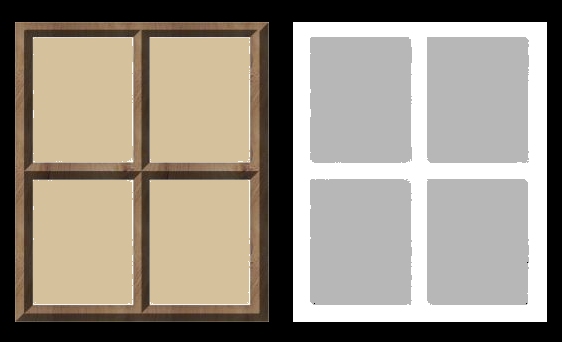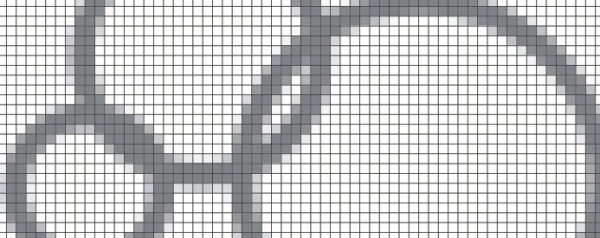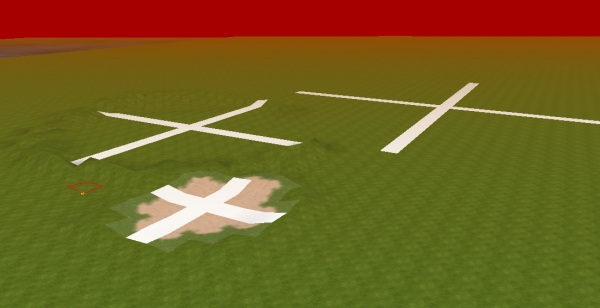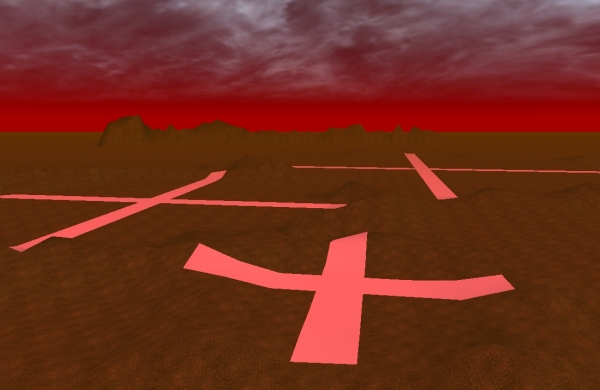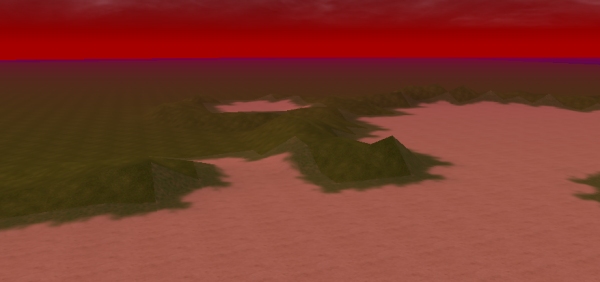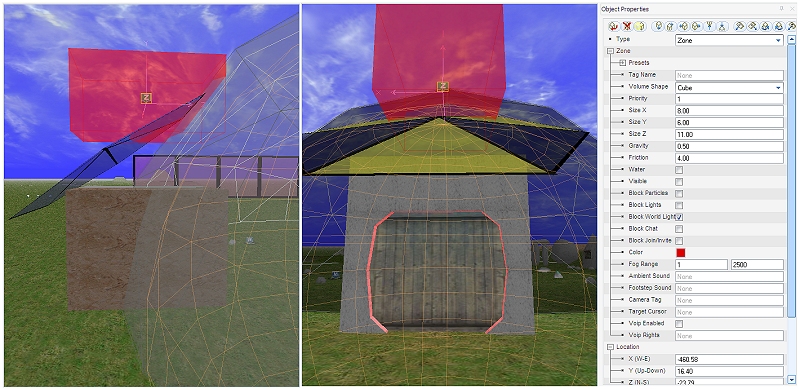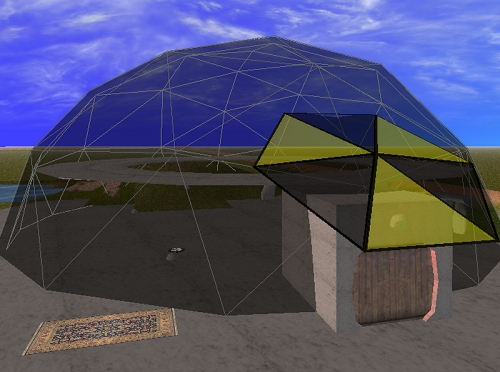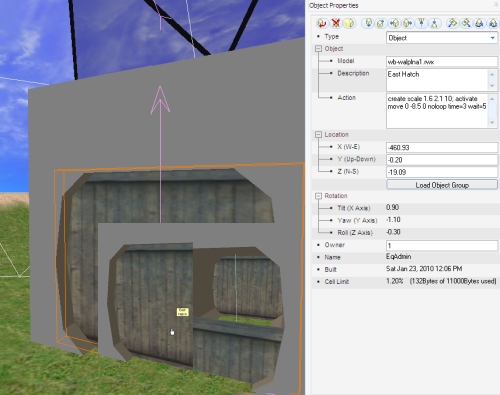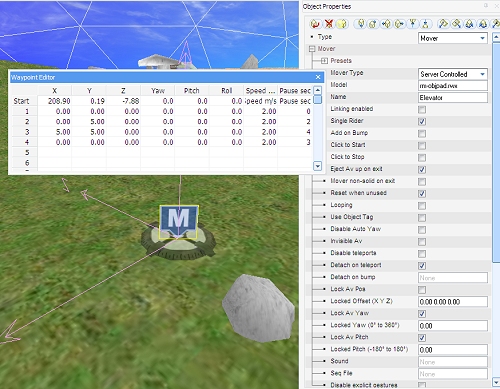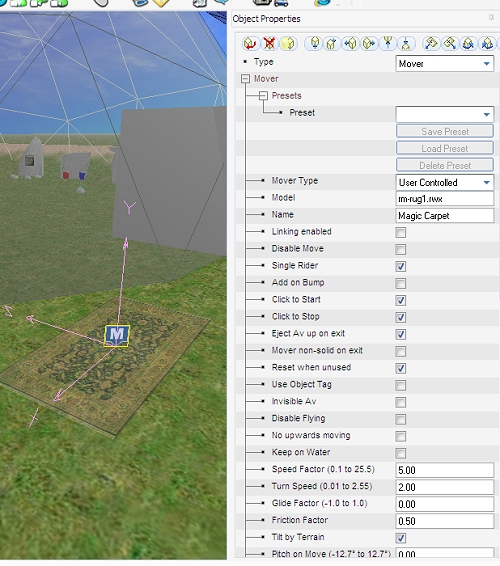Who was that masked man?
Texturing is an interesting process – it can transform a boring primitive into something exotic and interesting – finding the right textures can make or break a sim. Textures “tile” if the surface is larger than the actual texture patch, so getting edges that seamlessly fit together is an artform in itself.
Texture artists use many tricks of the trade, one of the, “masking”, is particularly useful- you can have a texture and pair it with another image – the combined image can be interesting.
If you pair images with equally dimensioned masks containing WHITESPACE in areas you want untouched and colour/texture in areas you want to affect, then the masked result is useful indeed:
create texture wwindow mask=wwindowm where wwindow was a jpg and wwindowm was a ZIPPED bmp, both uploaded to the textures folder of the public object path
The intensity of the “masked” area effects the transparency of the combined region – had I scuffed up the texture or the mask, the resultant combination would also appear flawed. The tint of the transparent region seems to be determined by the tint of the original texture (note a beighy cream), the mask grey-level determines the transparency – closer to black, the more transparent and so on.
Careful selection of textures can effect the look and feel of a space, transforming simple shapes into convincing scenic objects.
Objects of desire…
…now it puzzled me that our brand new, shiny world, kept referring back to activeworlds.com – not that I have anything against aw (far from it, they have been incredibly supportive to the n00b that is me). It seemed strange to me that all world geometry appeared to be coming from them – when EQ admins testing the world entered SciPrime, all they saw was broken objects (and not my partially raised buildings)
Seems aw is blocked on EQ networks, which got me thinking that we should do it differently anyway. After getting FTP access to the “webroot” of the host server for MyWorlds, I placed a folder called “objects”, then sub-folders called “models”, “textures”, “sounds” etc. Then downloaded objects from archives, uploaded them to their respective sub-folders and ….
After tweaking the world settings to re-direct the object path to our location, we now have locally hosted objects live in-world. Now I have only changed the object path of ONE world so far – “Obscura” (our sandbox building zone) – in doing so I have broken all the existing links to scenery and atmosphere which makes for an interestingly sparse blank world (think training room from Matrix) – but I was able to pop newly uploaded objects and they arrive nice and fast.
Next task – fully populate our object path and then I can switch all worlds to our object path, then we should be cooking. Quite happy with this, it means we can also add our own geometry as well, and may be able to work out how to let users upload geometry also – imagine how wonderful it would be for users to be able to sculpt their own 3d objects and let others use them in-world.
…back to marking for the moment tho … oooh, shiny! Dang this interweb is full of stuff I would much rather be messing with – you gotta do what you gotta do tho I guess.
Give me land, lots of land…
…so our UniServer is finally up, and there are four pristine worlds awaiting purposing. Scientia Prime (SciPrime or Sci’) is the first cab off the rank – our “Off-World” base camp and a “Science Outpost” will be located on this barren red planet.
So the current “Caretaker” (me) got my Avatar on (something perverse in me likes the notion of “Dilbert” making this world – apart from being a consummate geek, he is wearing a “Terrace” hooniform – lol.
Anyways, a plan is a necessity when you have 2km x 2km to play with. SciPrime (Sci’) is pockmarked with craters under an angry red sky, has a magnesium salt layer just under the surface and is generally hostile.
I thought it should be REALLY obvious we were not in Kansas anymore, hence the deliberate “mars” look and feel. The other worlds can be more earth-like but I want our cybernaughts to feel like they are otherworld bound. The abstraction and dislocation important in the roleplay and subsequent experiential learning activities.
On the northern section of Sci’ a cluster of 3 craters will house the main buildings (including meet and greet, comms centres, teleportery and the like.
By planning the elevations, and attending to scale, the middle-sized crater can house a single dome, the largest crater a cluster, connected by covered walkways, world entry point in the smallest crater and so on. The above map has it’s NORTH to the right, on the northern boundary of Sci’ there is a mountain range and a “hidden valley”, to provide some perspective eye candy.
Laying out the scenic elements was actually fairly challenging – the scale is huge – you may be able to see a red selection square bottom left – it is 10m square, making the larger of the craters (here seen merely as a cross hair marker) over 1/4 km wide.
Ideally, flying above the scenery is the easiest for “raising lumps and bumps” but Active Worlds seem to have this annoying habit of grounding you randomly in build mode … an observer would have been perplexed about the yo-yo-ing Dilbert, which in itself amuses me (not enough to make up for the frustration of the constant up and downing, but you get that). The lack of ability to position camera without actually travelling to where you are looking is actually annoying, particularly on this scale. More particularly, I must locate ways to select objects that are inside another object, without having to go inside that object myself – again, an annoyance but every world has its peculiarities I guess.
The “modularity” of the scenic chunks is both a blessing and a curse – getting reasonably organic terrain is actually fairly time consuming, but the texture tiling should make for some reasonably convincing effects. I have yet to gain access to the public object path, and it seems that this build is fairly incomplete so far – lots of objects and textures I had taken for granted are simply not there (yet) – this too shall pass when I get FTP access.
With geography roughed out, the process of texturing and tweaking begins, edges, boundaries and other transitions will take time to look nice but I want to get this right before plonking buildings on the ground – moving them when a terrain glitch is discovered is problematic so best to get that right.
Detailing, carving paths and walk-ways are the beginning of the process that will eventually see an alien but interesting landscape emerge.
All in all I am happy with my progress and feel I have made a good start – it is an interesting way to eat a weekend … the real world calls however, so I must be off for now, but have lots to do, all very interesting and some fascinating challenges ahead.
Looking forward to messing with textures, objects and the like as the devil is in the details (and by the looks I am cooking up an interesting version of hell 😛 )
In the “zone” and feeling moody
One issue with a “world” is the global settings – particularly lighting. Now if you are outside, this is fine, you would consistently want the sun/moon in the one place [although a multi-sun world might represent a challenge still]. The ambient light [that which generally soaks everything non-directionally and the directional light that originates from the major light source [the sun] as a global setting lets you pick intensity, angle and colour. These effect objects differently using the SUBTRACTIVE colour model – let me explain.
We see objects in the real world as a particular colour because the surface of those objects are reflecting THAT colour light into our eyes. A red shirt looks red in white light because white light contains some red – the shirt absorbs all but the red which it reflects and we see it – got it? In-world objects have colour schemes also – if the grass, for example is to be seen as green, then there must be some green in the directional or ambient light, else it will not appear green. Lighting in a virtual world [activeworld and secondlife] model this same system so some interesting moods can be created and commonly recognised objects can take on new qualities if illuminated using different colours to those it would naturally appear under white light.
… however
If you create a chamber, with a roof and solid walls, say, the world light settings seep through and plainly illuminate the inside space just like it is doing the outside – this is weird to say the least.
Activeworlds combat this issue by allowing you to create zone objects [rectangular prism, cylindrical and spherical] that let you apply local settings. In the above illustration, I have created and sized “red zone” to fit inside my airlock [but have yet to lower it in place]. Its ambient and direction lighting gives the user a feeling of being de-contaminated – red and dangerous looking. I also changed the local friction and gravity in this zone so it behaves like it is viscous to travel through. Similarly, inside the dome, I made a large spherical zone that filters outside light and lets my local lighting do the job it was placed to do.
So what? Zones will be very useful – we can make “holes” through our landscape but the global water table is just below the surface which by default means all stuff below that is full of water. To make a subterranean [or indeed a submarine or some breathable space below surface] you surround it in a zone that excludes the water and presto. Zones will let us make detailed and moody interiors as well which will greatly add to the sense of space.
With a simple concrete “plinth” in place, the dome looks a lot more like it belongs there [a narrow collar would also help from an engineering perspective given the inside struts etc – the beauty of a virtual world however is that the rules of building are not restricted by the forces of gravity or tightly bound to the laws for physics, popular culture or bad taste so we can get a little liberal with the building regulations depending on the culture we are depicting. I floated a second floor donut [well, technically it is a torus, but it is near lunchtime so donut is fine] as a circular viewing gallery – I will re-wire the lift to take you up and down I think and it might be useful practise plotting waypoints.
I added some programmed light sources to see if I could [I wonder how often exploration is justified for “shits and giggles”] and we start to get a feeling for the place. Above the the outside airlock there is a red light – when you activate the door, the door tells the light to go green [to indicate all is ok to enter]. When you travel beyond the threshold of the door it closes and changes the light back to red. I will leave my magic carpet parked outside, but might see if I can find a Dalek exoskeleton to travel around in [I am a geek if nothing else 😛 ].
Movers and shakers
I am working on a bunch of ideas, but common things like “airlocks” and doors are the first to get a guernsey. In our homebase, we will need airlocks – little intermediary chambers in between sectors.
There are a bunch of building primitives, so i made an elongated tunnel, purloined a “fence” segment [looked sort of industrial] and programmed it to slide down on activation – nothing new here. In the production airlock there will be a wall-mounted button to do this also, that would look more natural. It did however get me thinking about moving objects in general.
Now I have seen vehicles, lifts and other essential things in other Activeworlds, so decided it was high time I understood how these things work. It seems there are 3 “classes” of objects termed “movers”.
Server-controlled movers are objects that users ride but do not have any control over the path they take. Lifts and busses are examples of this sort of mover – you “hop on board” and initiate the trip somehow [activate = click, bump = coming in physical contact with] and the object then follows the pre-set path with the user on/in it. All movers let you “detach” yourself from them via a button-bar icon, but it would be normal to go for the full ride and have the mover detach itself from you automatically when you are safe, at your destination and most importantly stationary.
There are some nifty controls available when defining these things. The movement is controlled via a “waypoint editor” – you control the world coordinate displacement in XYZ, velocity, as well as the bumpiness of the ride [rock and roll] with pitch, yaw and roll. There are some complications using “add on bump” when you try to get off the mover – each movement is another “bump” whilst on the surface of the mover which can get interesting [or less so if you do not want to re-take the journey].
The amount of control you have here is quite feature-rich and if you choose a suitable “pad” object, quite natural movements can be achieved. This sort of mover has natural applications for lifts, travel tubes, roller coasters and so on where you get on, strap in and hang on.
User-controlled movers are a lot of fun – naturally I decided I needed a “magic carpet” and decided you would need to climb on board and then click to say you were ready for a ride [and again click when you wanted to get off]. Walking [and flying] unassisted is necessarily tedious in most virtual worlds – a user-controlled mover lets you go fast and can make the journey much more entertaining. Essentially, a user-controlled mover “enhances” player movement – speeding it up, making flying much more risky – the control you have over this form of transport is fairly detailed – I had the carpet dipping and rolling, banking and flapping on tight corners, so violently in some trials that it actually flung me off when I banked too hard. It is rare that I howl with laughter whilst experimenting but this was fun – the avatar and the object are also separately configurable – this means that, although the carpet is wildly flapping underneath me, my avatar is steady … or the other extreme where you lean, tilt and get chucked about.
Cars, spaceships, skateboards and gliders are but a few obvious applications of this type of mover. The world has a bunch of cars but I could not find one in the Q2 sim that actually let me drive – it might be that the config is confusing for little kids – I am sure however we can come up with “vanilla” recipes of setting for types of vehicles.
The third class of mover is a “pick-up” item that is attached to some part of the avatar [as per location tags above] – they are similar to user-controlled movers except you carry them around and choose when to wear them. I can see jet-packs, helicopter beanies and rocket-powered rollerblades as applications for this sort of mover. Because they are attached to the avatar, seeing them to remove them is problematic [indeed – server and user-controlled movers need to be big enough for you to see if you are relying on using activate to use them]. These become active when you attach them to you or hold them. Will play some more here when an application surfaces – they do not appear that different to user-controlled movers to warrant time now.
So what? I can see movers being very useful – transporters between locations, walk-through and guided tours of facilities, personal transportation and a bit of fun – if an oldie like me gets the giggles trying to hang on on a magic carpet ride, then I think our punters might like it also – especially if they can make and configure them themselves. Races take on a whole new meaning if you limit their speed setting but let them play with other parameters and get them to take to an obstacle course.
